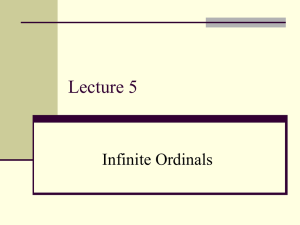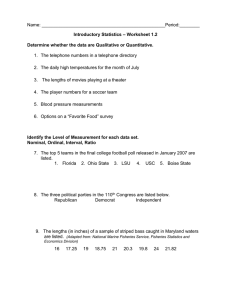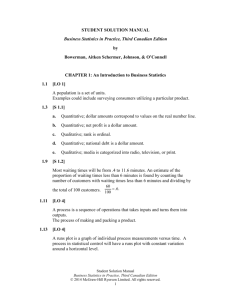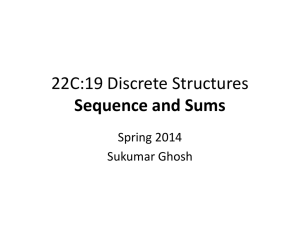SOME SET THEORY WE SHOULD KNOW CARDINALITY AND CARDINAL NUMBERS A |A|
advertisement
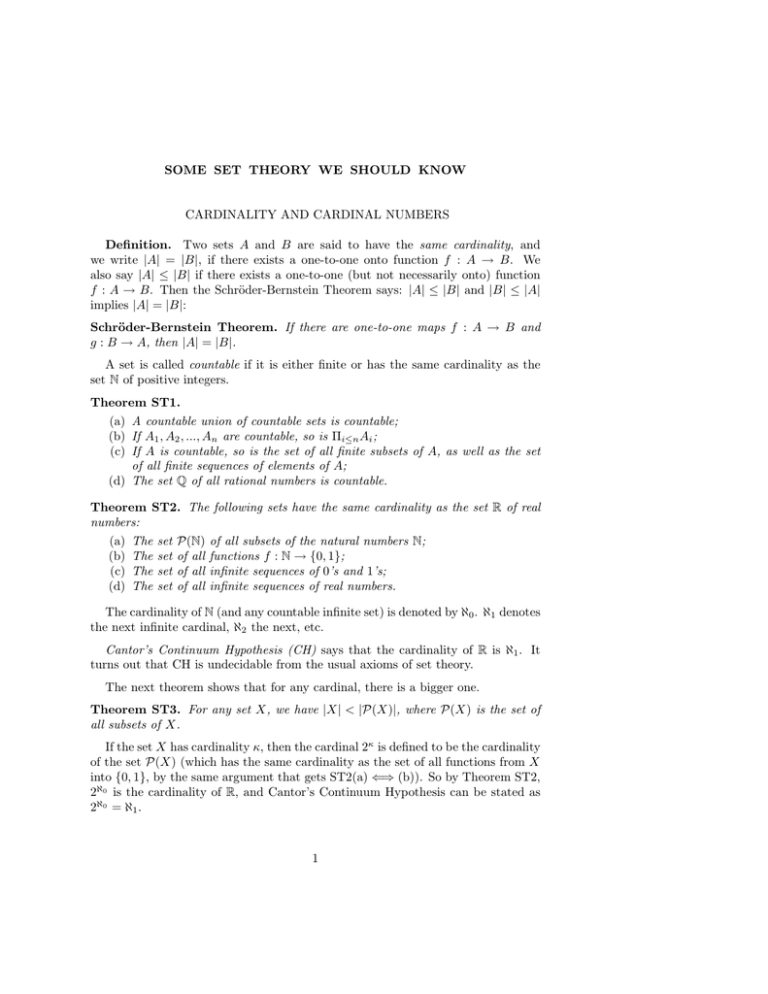
SOME SET THEORY WE SHOULD KNOW
CARDINALITY AND CARDINAL NUMBERS
Definition. Two sets A and B are said to have the same cardinality, and
we write |A| = |B|, if there exists a one-to-one onto function f : A → B. We
also say |A| ≤ |B| if there exists a one-to-one (but not necessarily onto) function
f : A → B. Then the Schröder-Bernstein Theorem says: |A| ≤ |B| and |B| ≤ |A|
implies |A| = |B|:
Schröder-Bernstein Theorem. If there are one-to-one maps f : A → B and
g : B → A, then |A| = |B|.
A set is called countable if it is either finite or has the same cardinality as the
set N of positive integers.
Theorem ST1.
(a) A countable union of countable sets is countable;
(b) If A1 , A2 , ..., An are countable, so is Πi≤n Ai ;
(c) If A is countable, so is the set of all finite subsets of A, as well as the set
of all finite sequences of elements of A;
(d) The set Q of all rational numbers is countable.
Theorem ST2. The following sets have the same cardinality as the set R of real
numbers:
(a) The set P(N) of all subsets of the natural numbers N;
(b) The set of all functions f : N → {0, 1};
(c) The set of all infinite sequences of 0’s and 1’s;
(d) The set of all infinite sequences of real numbers.
The cardinality of N (and any countable infinite set) is denoted by ℵ0 . ℵ1 denotes
the next infinite cardinal, ℵ2 the next, etc.
Cantor’s Continuum Hypothesis (CH) says that the cardinality of R is ℵ1 . It
turns out that CH is undecidable from the usual axioms of set theory.
The next theorem shows that for any cardinal, there is a bigger one.
Theorem ST3. For any set X, we have |X| < |P(X)|, where P(X) is the set of
all subsets of X.
If the set X has cardinality κ, then the cardinal 2κ is defined to be the cardinality
of the set P(X) (which has the same cardinality as the set of all functions from X
into {0, 1}, by the same argument that gets ST2(a) ⇐⇒ (b)). So by Theorem ST2,
2ℵ0 is the cardinality of R, and Cantor’s Continuum Hypothesis can be stated as
2ℵ0 = ℵ1 .
1
2
SOME SET THEORY WE SHOULD KNOW
ORDINAL NUMBERS AND TRANSFINITE INDUCTION
Definition. A relation R on a set X is a subset of X ×X. We write xRy to mean
(x, y) ∈ R. A partial order on X is a relation < satisfying, for every x, y, z ∈ X:
(i) x < y and y < x are not both true (antireflexive);
(ii) x < y and y < z implies x < z (transitive).
We also write x ≤ y to mean “x < y or x = y”. We say that < is a linear order if
the following also holds for any x, y ∈ X:
(iii) Either x < y, y < x, or x = y (trichotomy).
And finally, a linear order < is a well-order if also:
(iv) Every non-empty subset of X has a least element.
Two linearly ordered sets (A, <A ) and (B, <B ) are order- isomorphic if there is
a one-to-one onto order-preserving map h : A → B.
We will assume the following:
Theorem ST4. There is a class Ord and a linear ordering < on Ord with the
following properties:
(i) Every nonempty subset of Ord has a least element;
(ii) Given any well-ordered set (X, ≺), there is α ∈ Ord such that (X, ≺) is
order-isomorphic to (Pα , <), where Pα = {β ∈ Ord : β < α}.
Elements of Ord are called ordinals. Intuitively, an ordinal number denotes
position in a well-ordered sequence. The least ordinal is denoted by 0, the next by
1, the next by 2, etc. The least ordinal with infinitely many predecessors, i.e, the
least ordinal greater than all the finite ordinals 0, 1, 2, . . . , is denoted by ω. Then
comes ω + 1, ω + 2, . . . . The least ordinal bigger than ω + n for every n < ω is
denoted by ω · 2. One can similarly define ω · 3, ω · 4, . . . . The least ordinal bigger
than ω · n for all n < ω is denoted by ω · ω or ω 2 . Etc.
Note that all ordinals mentioned in the above paragraph have only countably
many predecessors. Such ordinals are called countable ordinals. The least ordinal
with uncountably many predecessors, i.e., the least ordinal greater than all of the
countable ordinals, is denoted by ω1 . A better definition of ℵ1 than the one given
above is that ℵ1 denotes the cardinality of the set of predecessors of ω1 . ℵ2 , ℵ3 , . . .
may be defined similarly. See below where ℵα is defined, by transfinite induction,
for any ordinal α.
Principle of Transfinite Induction. Let κ be an ordinal. Suppose we have for
each α < κ a statement Sα such that:
(i) S0 is true;
(ii) If β < κ and Sα is true for every α < β, then Sβ is true.
Then Sγ is true for every γ < κ.
Theorem ST5. Let α be any ordinal. Then the set [0, α] = {β ∈ On : 0 ≤ β ≤ α}
with the order topology (using the usual ordering on the ordinals) is a compact
Hausdorff space.
Lemma ST6. Let Ω denote the set of countable ordinals. If C is any countable
subset of Ω, then there is a countable ordinal α such that α ≥ β for any β ∈ C.
SOME SET THEORY WE SHOULD KNOW
3
Theorem ST7. Give the set Ω of all countable ordinals the order topology (using
the usual order on the ordinals). Then Ω with this topology is sequentially compact
(and so also countably compact) but not compact.
Principle of Definition by Transfinite Induction. Let κ be an ordinal, B a
set, and F the set of all functions (including the empty function) into B whose
domain is the set {β ∈ Ord : β < α} for some α < κ. Let R : F → B. Then there
is a unique function G with domain {α ∈ Ord : α < κ} such that, for any α < κ,
G(α) = R(G ¹ {β ∈ Ord : β < α})
.
Remark. The Transfinite Induction Principle and the Principle of Definition by
Transfinite Induction also hold, by the same proof, if in their statements we replace
κ by the class Ord of all ordinals.
Now the Principle of Definition by Transfinite Induction justifies defining ωα and
ℵα for any ordinal α as follows:
(i) ℵ0 is as defined previously, and ω0 = ω.
Suppose α is an ordinal and ωβ and ℵβ have been defined for every β < α.
(ii) If α has an immediate predecessor γ (which would make α = γ + 1), then
let ωα be the least ordinal with more than ℵγ -many predecessors, and let
ℵα denote the cardinality of the set of predecessors of ωα .
(iii) If α has no immediate predecessor, then let ωα be the least ordinal greater
than ωβ for every β < α. Again, let ℵα denote the cardinality of the set of
predecessors of ωα .
Exercise ST8.
(a) For each ordinal α < ω1 , there is a one-to-one order-preserving function
from {β ∈ Ord : β < α} to the real line R;
(b) There is no one-to-one order-preserving function from {β ∈ Ord : β < ω1 }
to the real line R.
AXIOM OF CHOICE AND EQUIVALENTS
Axiom of Choice. Given any collection A of nonempty sets, there is a function
f : A → ∪A such that f (A) ∈ A for every A ∈ A.
Zorn’s Lemma. Suppose (P, <) is a partially ordered set with the following property:
(∗) If L is any subset of P linearly ordered by <, then there is p ∈ P such that
l ≤ p for any l ∈ L.
Then there is an element q in P such that no member of P is strictly greater than
q.
An element q of the partial order P that satisfies the conclusion of Zorn’s Lemma
is called a maximal element of P .
Theorem ST9. The following are equivalent:
(a) The Axiom of Choice;
(b) Zorn’s Lemma;
(c) Every set can be well-ordered.


